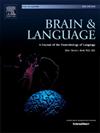Recursive self-feedback enables target language production in aphasia with pathological language mixing
IF 2.3
2区 心理学
Q1 AUDIOLOGY & SPEECH-LANGUAGE PATHOLOGY
引用次数: 0
Abstract
Stroke in bilingual adults can lead to aphasia with pathological language mixing (PLM), a rare neurological condition with limited treatment options. Recursive self-feedback (RSF) offers a self-directed approach, allowing individuals with PLM to iteratively self-monitor and correct their language mixing independently. We demonstrated the effects of RSF in a 59-year-old female bilingual speaker of Spanish and English (Patient P3) with severe Broca’s aphasia and PLM, 67-months poststroke. Over 14 intensive RSF sessions (2 h/day, 5 days/week, for 3 weeks), P3 used a mobile app to self-correct her mixing errors and increase the proportion of English words in her spontaneous speech. Post-treatment assessments showed improvements across both treated and untreated narrative prompts, with an 11-point increase in her Aphasia Quotient on the English version of the Western Aphasia Battery-Revised. These findings demonstrate that RSF enables target language production, yielding clinically meaningful language recovery in P3 without external cueing, modelling or feedback. RSF is a promising procedure for aphasia therapy, opening new pathways for targeting language access, control and recovery in aphasia and PLM.
递归自我反馈使病理性语言混合失语症的目标语产生成为可能
双语成人中风可导致病理性语言混合失语症(PLM),这是一种罕见的神经系统疾病,治疗方案有限。递归自我反馈(RSF)提供了一种自我导向的方法,允许使用PLM的个人迭代地自我监控并独立地纠正他们的语言混合。我们在一名59岁的西班牙语和英语双语女性患者(患者P3)中证实了RSF的效果,该患者患有严重的Broca失语症和PLM,中风后67个月。经过14次密集的RSF训练(每天2小时,每周5天,持续3周),P3使用手机应用程序自我纠正她的混合错误,并增加了英语单词在她自发讲话中的比例。治疗后的评估显示,在接受治疗和未接受治疗的情况下,她的叙事提示都有所改善,在英语版本的《西方失语电池修订版》中,她的失语商数增加了11分。这些发现表明,RSF能够产生目标语言,在没有外部提示、建模或反馈的情况下,在P3中产生具有临床意义的语言恢复。RSF是一种很有前景的失语治疗方法,为针对失语和PLM的语言获取、控制和恢复开辟了新的途径。
本文章由计算机程序翻译,如有差异,请以英文原文为准。
求助全文
约1分钟内获得全文
求助全文
来源期刊

Brain and Language
医学-神经科学
CiteScore
4.50
自引率
8.00%
发文量
82
审稿时长
20.5 weeks
期刊介绍:
An interdisciplinary journal, Brain and Language publishes articles that elucidate the complex relationships among language, brain, and behavior. The journal covers the large variety of modern techniques in cognitive neuroscience, including functional and structural brain imaging, electrophysiology, cellular and molecular neurobiology, genetics, lesion-based approaches, and computational modeling. All articles must relate to human language and be relevant to the understanding of its neurobiological and neurocognitive bases. Published articles in the journal are expected to have significant theoretical novelty and/or practical implications, and use perspectives and methods from psychology, linguistics, and neuroscience along with brain data and brain measures.
 求助内容:
求助内容: 应助结果提醒方式:
应助结果提醒方式:


